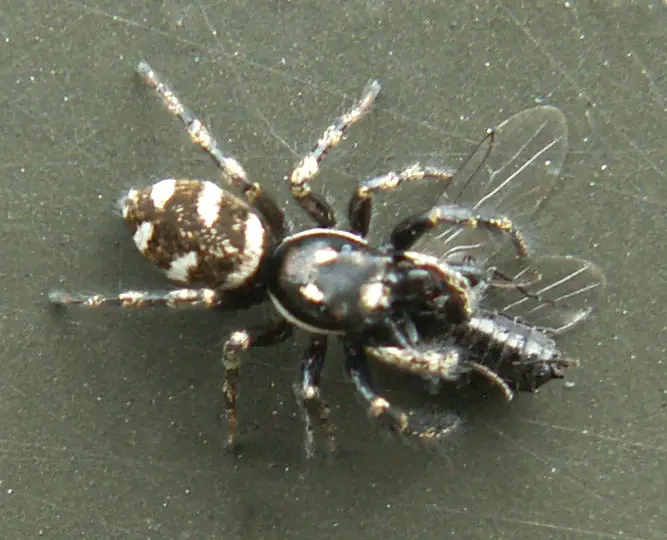Zebra Spider
The Zebra Spider is widespread in almost all the territories North of equator. They have massive bodies suited for their hunting technique – instead of catching victims in their web, they swiftly jump it. They have earned their name for the white stripes that stretch across the stomach.
Zebra Spiders are active during the day and they like warm, sunny weather. They inhabit a variety of landscapes, from human houses and gardens to even the Himalayan mountains 7000 metres above the sea level. In the evening, the spider finds a safe cover, creates a cocoon and spends the night in it. It’s interesting, that the Zebra Spider doesn’t go out if the weather is bad – if it’s rainy or windy, the spider will stay inside the cocoon for multiple days. They mostly lead solitary lives and they’re most often quite curious and not easily scared away, thus they can easily live in human houses.
This small predator (in length, reaching only 5 mm) catches a variety of flies, insects and bugs. The Zebra Spider has extremely sharp vision, which enables it to track even the tiniest movement. Unlike most other spiders, this species doesn’t weave a web and wait for victims to get trapped in it. Instead, they slowly and cautiously gets near the prey and then when the distance is short enough, perform a swift jump at the victim and immediately inject venom in it’s body. Interestingly, they also have a safety plan – before jumping, they attach a piece of web to the surface they’re jumping from and in case of an unsuccessful jump, they perform a kind of a bungee jump.
Like most spiders, the Zebra Spider male reaches sexual maturity sooner than the female. Trying to make a positive impression, the male performs a complex rut ritual, moving around the female with a part of his legs raised in the air. Sometimes the male gets so excited that doesn’t even notice that the he’s showing the dance to another male, instead of a female. It has also been observed that these spiders sometimes perform their ritual dance near a mirror or other reflective surface – they show off to themselves.
After copulation, the female creates a large cocoon and lays the eggs in it. She protects the “nest” for as long as the young spiderlings hatch. The hatchlings look like a miniature of their parents, but they’re coloured differently. They start hunting and immediately begin living on their own upon hatching. Before becoming fully mature, Zebra Spiders drop their skin multiple times. In captivity, they live for up to 2-3 years, while females usually have a longer life expectancy.




I think this website is good, but I want to know the sexual maturity of the zebra spider and how many eggs does it lay in a sac. Thank you for helping me in my work!
Hey there, Zhang!
Thanks for your interest in the site and sorry for the late reply. As for your questions – the time a Zebra Spider reaches sexual maturity depends on the conditions, namely the air temperature. As written above, in captivity Zebra Spiders live for up to 3 years, while in the wild their life expectancy varies from a few months to a bit over a year. In general, these animals reach sexual maturity a few months before the end of their lives.
As for the number of eggs – this hasn’t been discovered.